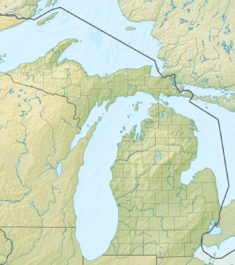Trenton Channel Power Plant
| Trenton Channel Power Plant | |
|---|---|
 |
|
| Country | United States |
| Location | 4695 West Jefferson Avenue Trenton, Michigan 48183 |
| Coordinates | 42°07′20″N 83°10′53″W / 42.12222°N 83.18139°WCoordinates: 42°07′20″N 83°10′53″W / 42.12222°N 83.18139°W |
| Status | Operating |
| Commission date | 1924 |
| Owner(s) | Detroit Edison |
The Trenton Channel Power Plant, also known as the Trenton Stacks, is a coal-burning power station located in Trenton, Michigan. Completed in 1924, it is owned and operated by Detroit Edison, a subsidiary of DTE Energy.
Part of the facility's property is on the mainland surrounding West Jefferson Avenue in southern Wayne County. The main building – the two-smokestack power station – and the coal yard are located on what is now technically the southern portion of Slocum's Island in the Detroit River. The facility shares this island with Elizabeth Park, which is separated from the facility by Grosse Ile Parkway. The Trenton Channel Power Station and the affiliated Sibley Quarry occupy 458 acres (185 ha) of land along the Detroit River, in which 225 acres (91 ha) of that property is open fields, woods, ponds, and sound berms.
The characteristic striped smokestacks were constructed with an innovative “smokestack within a smokestack” design to reduce the level of pollutants released. However, to better achieve this, the inner smokestacks were lined with asbestos that had to be later removed at great cost.
Despite its nature, the power plant works closely with environmental organizations to ensure the area is free of pollutants. Committed to reducing pollution and preserving the environment around Elizabeth Park, the Trenton Channel Power Plant became ISO 14001 certified in 2001. In 2002, the facility was designated a corporate wildlife habitat by the Wildlife Habitat Council. For their efforts, the Trenton Channel Power Plant and Sibley Quarry were co-awarded the Wildlife Habitat Council's Corporate Habitat of the Year award in 2004. The Trenton Channel Power Plant has also donated money and worked closely with Elizabeth Park and the Wayne County Department of Public Services for continued ecological preservation.
...
Wikipedia

